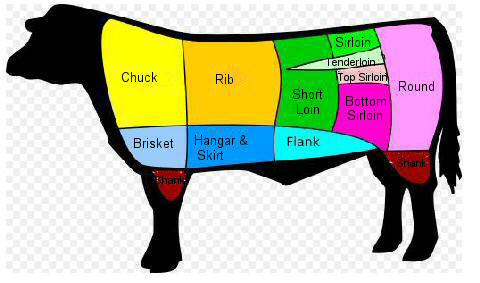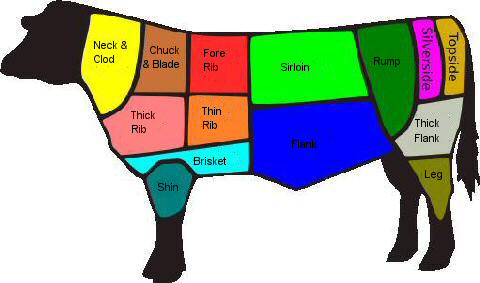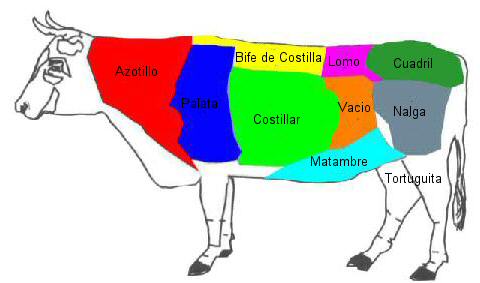“Whoe’er has gone thro’ London street,
Has seen a butcher gazing at his meat,
And how he keeps
Gloating upon a sheep’s
Or bullock’s personals,
as if his own;
How he admires his halves
And quarters–and his calves,
As if in truth upon his own legs grown.”– Thomas Hood, 19th century poet and humorist
Buenos Aires – One of the most common areas of questions I get is about the cuts of meat here in Argentina. The usual comes from an expat, looking for a particular cut of meat that they remember fondly from back home. Or sometimes it’s a visitor simply trying to figure out what part of the animal they’re ordering off a menu. And here’s the rub, as they say, beyond different names because it’s a different language, they’re simply not the same cuts of meat. Think of it this way – if I put a block of clay in front of you and tell you I want it divided into eight pieces that don’t have to be equal in size or form, I’m going to get a different division from every person I do that with. And, culturally, traditional ways to cut up an animal have come to vary from place to place – not just Argentina. Look, for example, at these first two diagrams (lifted and modified from answers.com, though I have the feeling they got them from elsewhere) – the “primary” cuts of beef in the U.S. and Britain (each primary cut gets further broken down into secondary cuts):


The first diagram is that of the primary cuts we’re used to in the U.S. (with a minor alteration, where I have “Hanger and Skirt” is tecnically referred to as the “Plate”). The second diagram is the same animal cut the way it would be cut in Britain. You can see that the animal is simply divided up in a very different manner, let alone different terminology. That’s not to say you can’t roughly approximate a particular steak between one country and another, but it would be hard to get the exact same thing.
Moving on to Argentina, the primary cuts look like this:

Now as I mentioned, these are just the primary cuts – for example, if one starts along the spine of the animal, moving from about midway through the azotillo and on through the bife de costilla, the individual cuts are the aguja, bife ancho, & bife angosta. The cuadríl is divided into the cuadríl, colita de cuadríl, & peceto. The costillar is split into part of the bife de chorizo and various rib cuts, while the paleta, continues down to the falda and then into that white space in front of the matambre. Inside of that, surrounding the diaphragm, is the entraña, or hanger steak. The ever popular bife de chorizo runs basically the same as a U.S. tenderloin, along the bottom of the lomo and on into the top of the costillar, basically forming a giant chorizo, or sausage, shaped cut that is on the inside of the ribs.
The most common cuts you’ll see in steakhouses, and their closest U.S. equivalents, since those are the ones I’m most familiar with (keeping in mind that they are almost all served boneless here), are:
asado de tira – ribs, but cross cut in strips (with bone)
bife de lomo – sirloin
bife de chorizo – tenderloin
cuadríl – rump steak
entraña – hanger steak
ojo de bife – rib-eye
peceto – top round, the “best” end of it is essentially a filet mignon
vacio – flank steak
falda – skirt steak
matambre – flank steak where it continues across the belly
Three other terms to know, though only two that you’re likely to see on a menu – ternera is a calf that is 1-2 years old, novillo is a male calf that is 2-3 years old (there is some overlap of the categories as the grading is partially by weight), vaquillona is a female calf, 2-3 years old, but I’ve never seen that on a menu, though very occasionally in a butcher shop.
Obviously there are more cuts here and there that aren’t diagrammed or explained, but hopefully this gives a good basic overview, and gives a sense of why it’s so hard to answer the question when someone asks for a direct translation.
The “entraña” or “entrañita” belongs to the inner part of the carcass. It is the lateral muscle of the diaphragm, while the center part of it is the “centro de entraña”
Hi Dan, Question about the Argentinian beef diagram. If I want to make a stew, and want to use the Arg. equivalent to U.S. chuck roast, what would I ask for, or how would it be labeled in the store? Your article is extremely helpful, as I’ve been kind of afraid to buy meat, not knowing the cut, and therefore not knowing how to cook it.
Well, as pointed out, you’re not really going to find the same cut. However, just based on the diagram and the area where a chuck roast is normally cut from, it would be the azotillo which is a shoulder roast. In some places it might be labelled as a marucha, though that’s not, from what I’ve seen, very common. More commonly for stew I think people tend to use carnaza, or stewing beef, or a cut of the nalga, both more or less from the area we might think of as a rump roast.
Hey guys! a tender cut to make stew is “roast beef”. I usually ask the butcher to do away with the fat and dice it for me. Another tender cut is “cuadrada” or “cuadril”
No idea where they come from, but they really do the magic in Irish stews or family casseroles
Cheers!
The rosbif as it’s called here is the same cut we’d call a roast beef, as Meli alluded to – it’s usually the upper part of the nalga, i.e., the rump. Cuadril is the part above that, as you can see on the diagram.
Dan, I’ve been making matambre here in North Carolina using flank steak, butterflied. I remember from my years in BAires that you could buy the matambre all ready and rolled up, just lovely, at the meat grocer’s. Is there a different trick you recommend for those of us stuck here, to get the nice, flat, wide and thin matambre?
Some of your crossing cut names are very wrong, to the point you call peceto, filet mignon when it is round beef and tenderloin bife de chorizo while tenderloin or filet mignon is lomo en Argentina.
You need to review most of your cuts because people will be disappointed thinking their meet is bad but what’s bad is the cut name
Sorry, but that’s just not accurate. Filet mignon is not lomo – though it can be cut from the tenderest part of one. In fact, ilet mignon is not even a cut here in Argentina (though some seem to think it is, but it’s not the same thing, from my perspective as a chef), other than by special request. The lomo and the chorizo are the two opposing sides of a t-bone or porterhouse, essentially. Some would call the lomo side the New York strip (though I’d go with bife angosta for that) – these names get a bit murky at times, as even in the US, a given part of the animal may have a different name. In fact, depending on where you are, the filet mignon can be cut from the tenderloin, the sirloin, or the far end of the top round. But in general, I’ll stick with my definitions based on how the cow was cut where I grew up in the Midwest US. Feel free to be disappointed.
Hard to say, given that it really is such a different way the meat is butchered. Here, the whole matambre is basically cut into strips about 6″ wide as its cut. You might try asking a local butcher if, when they do the cut, they leave the flank whole like that rather than making individual steaks. If you’ve got a good butcher, and you explain why you need it that way, I’d bet they could do it for you.
Is it safe to say that eating in an Argentinean steak house anywhere that does not serve good beef is a waste of money? We ate at one in Costa Rica and Columbia (both places are known for terrible cattle), and realized that we were getting ripped off because we were still eating bad beef. Even though they have different cuts than us, its not going to make bad beef taste good. Do a lot of people fall for this trap?
I’m not really sure what you’re asking Randy… I’d say it’s safe to say that eating anywhere, Argentine or not, that doesn’t serve good beef is a waste of money – paying for bad food isn’t a smart move – either financially or gastonromically. If you’re trying to suggest that eating non-Argentine beef is a rip-off while eating Argentine is a good deal, that’s too general – some places are good, some aren’t, some ranchers treat their cattle well, others don’t. I guess I’m not sure what the “trap” is. But it’s not because of the particular cuts, it’s just the quality of the beef itself, regardless of how it’s cut.
Thanks for your response. I guess the point I was trying to make was that an Argentinian steak place in Costa Rica charges a lot more for a steak than a Costa Rican steak place in Costa Rica does. But its the same exact beef that they both serve. So I guess (unless you like the ambiance or something), going to an Argentinian steak house in a country other than Argentina is a good way to overpay for a potentially bad steak. I think that a lot of people (unless its just us that fell for this) potentially go to Argentinian restaurants all over the world thinking that they may be getting a much better steak than they actually are.
Well I guess the question would be if they’re using Costa Rican beef or are they importing Argentine beef? If the latter, you may very well be getting a far better steak. Outside of the beef itself, there’s nothing that particular to an “Argentine steakhouse” that would make it different from other steakhouses, so if they’re not importing the beef, then yeah, it’s more or less just a gimmick. (Oh, and it helps if they know how to cook it right too!)
Dan,interesting article,been trying to sort out the cuts from
england compared to argentina and it isnt easy but i am a bit wiser now.i checked the price of sirloin today £26 kilo and was
trying to tell my friend in La Plata what the cut would be there
to compare prices.So think that is the dearest and lomo is the dearest to compare with.agree.
cheers dani
Dani – yeah, right now, I think that good bife de lomo is running somewhere around 85-90 pesos a kilo here, it’s really gone up (you can also find it much cheaper, down around 55-60, but of noticeably lower quality). So that’s just about half of what you’re paying there – somewhere around £12-13/kilo.
Dan,
I am living in Texas, and the most delisious meat here is the Texan Brisket. I am planning to visit some friends in Argentina at end of the year and I want to cook it for them. However, can you please help me with the equivalent to brisket in Argentina?
Thanks!
Alberto – as noted in the post, coming up with the same cut isn’t just a matter of translation, the cow is simply cut differently. The closest to a brisket here is, according to our local Texas replant smoked meat master, tapa de asado, but, it’s only part of what we might consider the brisket and continues into areas we wouldn’t. There’s also the pechito, the “little breast”, but again, it’s a matter of a weird overlap, and usually comes with at least a couple of the rib bones still in it. Others say falda, though that falls a bit outside of the brisket’s area, more down the stomach direction.